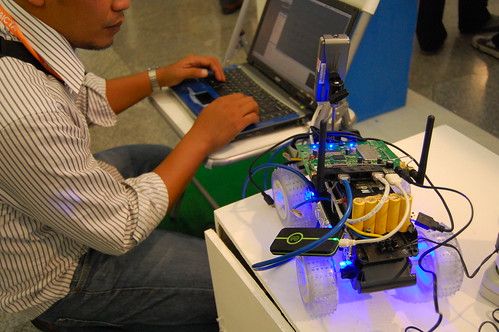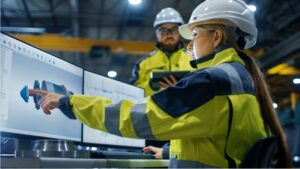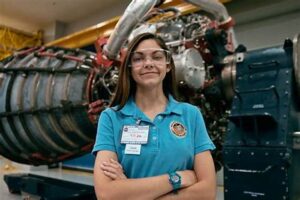Top 20 Mechatronics Engineer Fresher Interview Questions
Top 20 Mechatronics Engineer Fresher Interview Questions
Table of Contents
1. What is Mechatronics Engineering?
Example – “Mechatronics Engineering is an interdisciplinary field that integrates mechanical and electronic engineering with computer science to design and create intelligent systems and products. These systems often involve mechanical components, sensors, actuators, and microcontrollers, all working together seamlessly.”
2. Explain the difference between Mechatronics and Mechanical Engineering.
Example – “Mechatronics focuses on the integration of mechanical and electronic components to create smart systems, while mechanical engineering primarily deals with the design and analysis of mechanical systems. Mechatronics Engineers have expertise in both mechanical and electronic aspects, making them versatile in various industries.”
3. Can you name some common sensors used in Mechatronics?
Example – “Certainly, common sensors used in Mechatronics include:”
- Proximity sensors
- Accelerometers
- Gyroscopes
- Temperature sensors
- Pressure sensors
- Ultrasonic sensors
4. Describe a project where you successfully integrated mechanical and electronic components.
Example – “In a previous project, I designed an autonomous robot for warehouse logistics. This robot utilized a combination of mechanical components such as wheels, motors, and a robotic arm, along with electronic components like infrared sensors and microcontrollers. The mechanical components allowed the robot to move and manipulate objects, while the sensors and microcontroller enabled it to navigate, detect obstacles, and perform tasks autonomously.”
5. What programming languages are essential for Mechatronics Engineers?
Example – “Mechatronics Engineers should be proficient in programming languages like C, C++, and Python. These languages are commonly used for microcontroller programming and interfacing with electronic components.”
6. How do you troubleshoot a malfunctioning robotic system?
Example – “Troubleshooting a malfunctioning robotic system involves a systematic approach. First, I would check the power supply and connections to ensure they are secure. Then, I would review the code for any logical errors. If the issue persists, I would use diagnostic tools like multimeters and oscilloscopes to analyze sensor inputs and actuator outputs. Lastly, I would inspect the mechanical components for physical damage or wear and tear.”
7. Define PID control.
Example – “PID control stands for Proportional-Integral-Derivative control. It’s a feedback control system widely used in Mechatronics to maintain a desired setpoint. PID control calculates an error value as the difference between a desired setpoint and a measured process variable. It then applies proportional, integral, and derivative terms to the error value to adjust the control input and bring the process variable closer to the setpoint.”
8. What is the significance of feedback control in Mechatronics?
Example – “Feedback control is crucial in Mechatronics because it allows systems to continuously adjust and maintain desired conditions. In Mechatronics systems, sensors provide feedback on various parameters, and the control algorithm uses this information to make real-time adjustments. This ensures the performance and stability of the system.”
9. Explain the concept of PWM (Pulse Width Modulation).
Example – “PWM is a modulation technique used to control the amount of power delivered to an electronic device. It works by rapidly switching the output voltage on and off at varying duty cycles. By changing the width of the pulses, PWM can effectively control the average voltage delivered to a component, such as a motor, thus regulating its speed or position.”
10. How do you calculate the gear ratio in a gearbox?
Example – “The gear ratio in a gearbox is calculated by dividing the number of teeth on the driven gear by the number of teeth on the driving gear. For example, if the driving gear has 20 teeth, and the driven gear has 40 teeth, the gear ratio would be 40/20 or 2:1. This means that for every two revolutions of the driving gear, the driven gear completes one revolution.”
11. What are the key considerations when designing a robotic arm?
Example – “When designing a robotic arm, several key considerations come into play, including:”
- Payload capacity
- Reach and workspace
- Degrees of freedom
- Actuator selection (e.g., motors or servos)
- End-effector design
- Control system for precise movements
- Safety features to prevent collisions
12. How do you program a microcontroller for a Mechatronics project?
Example – “Programming a microcontroller involves writing code to control the microcontroller’s inputs and outputs. I typically use C or C++ for microcontroller programming. I write code to read sensor data, process it, and control actuators accordingly. Additionally, I ensure that the code is efficient, reliable, and optimized for the specific microcontroller model being used.”
13. Can you explain the concept of real-time operating systems (RTOS)?
Example – “A real-time operating system (RTOS) is an operating system designed for applications that require precise and predictable responses to external events. In Mechatronics, RTOSs are used to manage tasks with strict timing requirements. These systems ensure that critical tasks are executed on time, making them essential for real-time control applications like robotics and automation.”
14. How do you ensure effective communication between electrical and mechanical engineering teams?
Example – “Effective communication between electrical and mechanical engineering teams is crucial for successful Mechatronics projects. I ensure communication by:”
- Participating in cross-functional meetings
- Using a common project management platform
- Sharing detailed documentation
- Encouraging open dialogue and collaboration
- Conducting regular status updates
15. Describe a situation where a project you were working on faced a critical issue. How did you handle it?
Example – “In a robotics project, we encountered a critical issue where the robot’s navigation system failed during a live demonstration. I took immediate action by isolating the robot to prevent any accidents. Then, I gathered the team to brainstorm and identify the root cause. We discovered a software bug that caused the issue and quickly developed a patch to fix it. The crisis was averted, and the demonstration proceeded successfully.”
16. How do you stay updated with the latest advancements in Mechatronics?
Example – “Staying updated in Mechatronics is vital. I regularly read industry journals, attend conferences, and participate in online forums and webinars. Additionally, I take online courses and engage in hands-on projects to gain practical experience with emerging technologies. Continuous learning is essential in this rapidly evolving field.”
17. What is the role of a Mechatronics Engineer in a manufacturing setting?
Example – “A Mechatronics Engineer plays a crucial role in manufacturing by designing, developing, and maintaining automated systems that improve efficiency and product quality. They integrate mechanical, electronic, and computer engineering principles to create automated machinery, robots, and control systems. Their responsibilities include troubleshooting and optimizing these systems to ensure smooth production processes.”
18. What programming languages are commonly used in Mechatronics, and which one would you recommend for a beginner?
Example – “Common programming languages in Mechatronics include C, C++, and Python. For beginners, I recommend starting with Python. It’s known for its simplicity and readability, making it an excellent choice for learning programming concepts. As you progress, you can explore C and C++ for microcontroller programming and real-time applications.”
19. Can you explain the concept of feedback control in Mechatronics?
Example – “Feedback control is fundamental in Mechatronics. It involves continuously monitoring a system’s output (the “feedback”) and making adjustments to maintain a desired setpoint. For instance, in a temperature control system, sensors measure the temperature (feedback), and the controller adjusts the heating or cooling elements to keep the temperature close to the setpoint. This ensures the system’s stability and accuracy.”
20. How do you approach the design of a robotic arm for a specific task?
Example – “Designing a robotic arm involves several steps:”
- Define the task: Understand the specific task the robotic arm will perform.
- Determine the payload: Calculate the weight the arm needs to lift or manipulate.
- Select actuators: Choose motors or servos based on the task and payload.
- Plan the kinematics: Determine the arm’s range of motion and degrees of freedom.
- Design the end-effector: Create a tool or gripper suitable for the task.
- Develop control algorithms: Write software to control the arm’s movements accurately.
- Incorporate safety features: Include sensors and software to prevent collisions and ensure safe operation.




